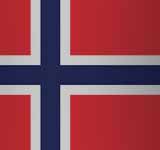Norway is a constitutional monarchy that uses a system of parliamentary government. Its parliament, Stortinget, has 169 members (previously 165, then added 4 people on 12 September 2005) who were chosen for a 4-year term.
2. Iceland
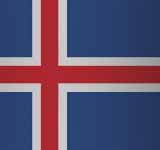
Iceland is a sovereign country located in the northwest corner of Europe, whose territory covers the homonymous island and some small islands and adjacent islets in the Atlantic Ocean, between the rest of Europe and Greenland. Its capital is Reykjavik. It has a population of about 350,000 inhabitants and an area of 103,000 km². Because of its location on the Mid - Atlantic Ridge, is a country with highly active volcanic and geological, a factor that greatly affects the landscape of Icelandic territory. The interior of the country consists of a plateau characterized by deserts, mountains, glaciers and glacial rivers that flow to the sea through the lowlands. Thanks to the effects of the Gulf Stream, it has a mild climate in relation to its latitude and provides a habitable environment.
3. Denmark - Kingdom of Denmark
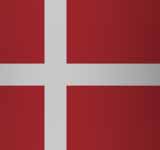
The Denmark, officially the Kingdom of Denmark, is a country ruler of northern Europe and Scandinavia, whose metropolitan territory is located in the south of Norway, from which it is separated by the North Sea, to the west of Sweden, the Øresundacting as a natural frontier, and in the north of Germany, the only country with which it shares a land border. Its capital is Copenhagen. Denmark covers an area of 42924 km2, making it the smallest state in Scandinavia, but total area of 2210579 km2 including the Faroe Islands and Greenland. It had a population of 5.75 million in 2016. A mostly flat country, its territory is composed of agricultural areas and sandy coasts.
4. Switzerland - Swiss Confederation
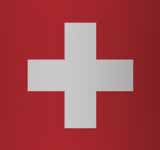
Switzerland, officially Swiss Confederation, is a landlocked country located in central Europe and that has a population of 8,500,000 inhabitants (2018). Switzerland is a federated republic of 26 states, called cantons. Bern is the seat of federal authorities, while the country's financial centers are located in the cities of Zurich, Basel, Geneva and Lugano. Switzerland is the fourth richest country in the world, according to its GDP per capita, with US $ 83,718 (2011). Switzerland has one of the economies capitalists more stable, powerful and modern in the world, located in the top ten according to the Economic Freedom Index 2009. The nominal GDP per capita in Switzerland is higher than most of European economies, second only to Luxembourg. The purchasing power parity index (PPP) of Switzerland is among the fifteen best in the world. Switzerland's economy is the second most competitive in the world.
5. Finland - Republic of Finland
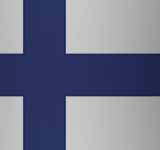
Finland, officially the Republic of Finland, is a country in Northern Europe with 5,518,371 (2017) inhabitants. Finland borders on Russia to the east, Norway to the north and Sweden to the northwest. To the south, it is separated from Estonia by the Gulf of Finland. To the west lies the Gulf of Bothnia and to the southwest the Baltic Sea on the other side of which lies neighbor Sweden. The capital is Helsinki. Finland is sometimes called 'the land of a thousand lakes', in reality there are approximately 188,000 lakes. The largest lake is Lake Saimaa. In the southeast the country is speckled with countless lakes and ponds. The country is a democratic republic with an elected president. The presidency of Finland lasts six years, plus a possible re-election of another six years, resulting in a maximum presidency of twelve years.
6. Netherlands - Kingdom of the Netherlands

The Netherlands is one of the countries within the Kingdom of the Netherlands. The majority of the Netherlands is in northwest Europe, on the North Sea. In addition to the European part, there are the three special municipalities in the Caribbean Sea, which are also referred to as the Caribbean Netherlands. The European Netherlands is bordered in the south by Belgium, along the east border by Germany and on the west and north by the sea. The capital of the Netherlands is Amsterdam, the government seat is The Hague. The Netherlands has a population of 17,084,719 (2017) and with an area of 41,543 km² a high population density of 411.3/km² (2017). More than 18% of the surface consists of water and a large part of the land and population is below sea level. The land is protected against the water through a system of dikes and waterworks. Polders have been created through land reclamation. Administratively, the country is divided into twelve provinces.
7. New Zealand
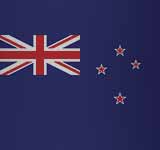
New Zealand, notable for its geographical isolation, is located about 2000 kilometers southeast of Australia in the Tasman Sea, and its closest neighbors to the north are New Caledonia, Fiji and Tonga. Due to this long isolation, an endemic fauna dominated by birds developed in the country, many of which became extinct after the arrival of humans and mammals that they introduced without any control. Most of the New Zealand population is of European descent, Maori Indians are the largest minority. Asians and Polynesians are also significant minorities, especially in urban areas. Although it has three official languages the most spoken, by far, it is English.
8. Canada
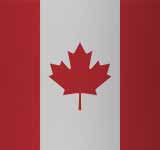
Located at the north end of the North American subcontinent, it extends from the Atlantic Ocean to the east, the Pacific Ocean to the west, and north to the Arctic Ocean. It shares a border with the United States to the south, and to the northwest with its federated state Alaska. It is the second largest country in the world after Russia, and also the most northern. It occupies about half of the territory of North America. Because of its climate, it is one of the 15 countries with the lowest population density in the world, with approximately 4 inhabitants per square kilometer.
9. Australia - Commonwealth of Australia

Australia has been inhabited for at least forty-six thousand years by Australian Aborigines. Their discovery would have occurred after the sporadic visits of Spaniards and Portuguese who explored the northern and western coast of Australia, although without advancing inland due to the small number of explorers. Scans initiated in the seventeenth century were continued by Dutch fishermen, explorers and traders Europeans. So far it is argued that the first to disembark on the eastern shores was the British navigator James Cook that arrived in 1769 to New Zealand and in 1770 to Australian lands. Due to this, the eastern half of the continent was claimed by Great Britain in 1770, and in 1788 a penal colony was established in New South Wales.
10. Sweden - Kingdom of Sweden
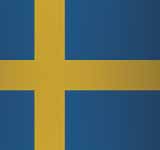
Sweden, officially Kingdom of Sweden is a Scandinavian country in Northern Europe that is part of the European Union (EU). It is bordered to the north by Norway and Finland, to the east by Finland and the Gulf of Bothnia, to the south by the Baltic Sea and to the west by the North Sea and Norway. It has land borders with Norway and Finland, and is connected to Denmark by the bridge of Ersund. Its most populous city is Stockholm, which is also its capital. With an area of 450,295 km2, is the fifth largest country in Europe. In 2016, it had a total population of just over 10 million people, of whom 98% have Internet access, making it the country with the highest penetration of service in the world. It has a population density of only 22/km2, similar to other countries around it. About 84% of the population lives in urban areas. Swedes enjoy a high standard of living, with a non-hierarchical corporate organization and culture, and collectivist compared to their Anglo-Saxon counterparts. Nature conservation, environmental protection and energy efficiency are generally a priority in policy-making and are welcomed by much of the people. It maintains the Nordic model of well-being that provides universal health care and free tertiary education to its citizens, has the eleventh highest per capita income in the world, and ranks high in numerous human development measurements, including quality of life, safety, health, education, equality, and prosperity.
11. Costa Rica - Republic of Costa Rica

12. Israel - State of Israel

13. Austria - Republic of Austria
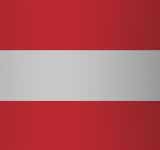
14. United States - United States of America
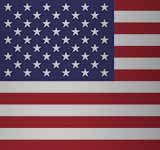
15. Germany - Federal Republic of Germany

16. Ireland
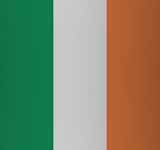
17. Belgium - Kingdom of Belgium

18. Luxembourg - Grand Duchy of Luxembourg

19. United Kingdom - United Kingdom of Great Britain and Northern Ireland

20. Chile - Republic of Chile

21. United Arab Emirates

22. Czech Republic

23. Argentina - Argentine Republic
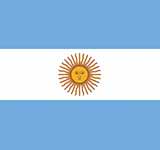
24. Brazil - Federative Republic of Brazil

25. Mexico - United Mexican States

26. Singapore - Republic of Singapore

27. Malta - Republic of Malta

28. Uruguay - Oriental Republic of Uruguay

29. Guatemala - Republic of Guatemala

30. Panama - Republic of Panama

31. France - French Republic

32. Thailand - Kingdom of Thailand

33. Taiwan - Republic of China

34. Spain - Kingdom of Spain

35. Qatar - State of Qatar

36. Colombia - Republic of Colombia

37. Saudi Arabia - Kingdom of Saudi Arabia

38. Trinidad and Tobago - Republic of Trinidad and Tobago

39. Kuwait - State of Kuwait

40. Slovakia - Slovak Republic

41. Bahrain - Kingdom of Bahrain

42. Malaysia

43. Nicaragua - Republic of Nicaragua

44. Ecuador - Republic of Ecuador

45. El Salvador - Republic of El Salvador

46. Poland - Republic of Poland

47. Uzbekistan - Republic of Uzbekistan

48. Italy - Italian Republic

49. Russia - Russian Federation

50. Belize

51. Japan

52. Lithuania - Republic of Lithuania

53. Algeria - People's Democratic Republic of Algeria
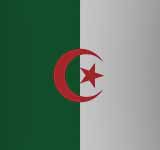
54. Latvia - Republic of Latvia

55. Moldova - Republic of Moldova

56. Korea, South - Republic of Korea

57. Romania

58. Bolivia - Plurinational State of Bolivia

59. Turkmenistan

60. Kazakhstan - Republic of Kazakhstan

61. Northern Cyprus - Turkish Republic of Northern Cyprus

62. Slovenia - Republic of Slovenia

63. Peru - Republic of Peru

64. Mauritius - Republic of Mauritius

65. Cyprus - Republic of Cyprus

66. Estonia - Republic of Estonia

67. Belarus - Republic of Belarus

68. Libya

69. Turkey - Republic of Turkey

70. Paraguay - Republic of Paraguay

71. Philippines - Republic of the Philippines

72. Serbia - Republic of Serbia

73. Jordan - Hashemite Kingdom of Jordan

74. Hungary

75. Jamaica

76. Croatia - Republic of Croatia

77. Kosovo - Republic of Kosovo

78. China - People's Republic of China

79. Indonesia - Republic of Indonesia

80. Pakistan - Islamic Republic of Pakistan

81. Venezuela - Bolivarian Republic of Venezuela

82. Montenegro

83. Morocco - Kingdom of Morocco

84. Azerbaijan - Republic of Azerbaijan

85. Dominican Republic

86. Greece - Hellenic Republic

87. Lebanon - Lebanese Republic

88. Portugal - Portuguese Republic

89. Bosnia and Herzegovina

90. Honduras - Republic of Honduras

91. Macedonia - Republic of Macedonia

92. Somalia - Federal Republic of Somalia

93. Vietnam - Socialist Republic of Vietnam

94. Nigeria - Federal Republic of Nigeria

95. Tajikistan - Republic of Tajikistan

96. Bhutan - Kingdom of Bhutan

97. Kyrgyzstan - Kyrgyz Republic

98. Nepal - Federal Democratic Republic of Nepal

99. Mongolia

100. South Africa - Republic of South Africa

101. Tunisia - Tunisian Republic

102. Palestine - State of Palestine

103. Egypt - Arab Republic of Egypt

104. Bulgaria - Republic of Bulgaria

105. Sierra Leone - Republic of Sierra Leone

106. Cameroon - Republic of Cameroon

107. Iran - Islamic Republic of Iran

108. Albania - Republic of Albania
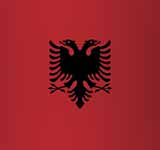
109. Bangladesh - People's Republic of Bangladesh

110. Namibia - Republic of Namibia

111. Kenya - Republic of Kenya

112. Mozambique - Republic of Mozambique

113. Myanmar - Republic of the Union of Myanmar (Burma)

114. Senegal - Republic of Senegal

115. Zambia - Republic of Zambia

116. Iraq - Republic of Iraq

117. Gabon - Gabonese Republic

118. Ethiopia - Federal Democratic Republic of Ethiopia

119. India - Republic of India

120. Sri Lanka - Democratic Socialist Republic of Sri Lanka

121. Armenia - Republic of Armenia

122. Mauritania - Islamic Republic of Mauritania

123. Congo - Democratic Republic of the Congo

124. Congo - Republic of the Congo

125. Georgia

126. Mali - Republic of Mali

127. Ivory Coast - Republic of Côte d'Ivoire

128. Cambodia - Kingdom of Cambodia

129. Sudan - Republic of the Sudan

130. Ghana - Republic of Ghana

131. Ukraine

132. Uganda - Republic of Uganda

133. Burkina Faso

134. Niger - Republic of Niger

135. Malawi - Republic of Malawi

136. Chad - Republic of Chad

137. Zimbabwe - Republic of Zimbabwe

138. Lesotho - Kingdom of Lesotho

139. Afghanistan - Islamic Republic of Afghanistan
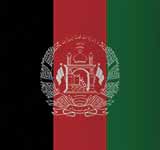
140. Angola - Republic of Angola
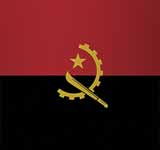
141. Botswana - Republic of Botswana

142. Benin - Republic of Benin

143. Madagascar - Republic of Madagascar

144. Haiti - Republic of Haiti

145. Yemen - Republic of Yemen

146. South Sudan - Republic of South Sudan

147. Liberia - Republic of Liberia

148. Guinea - Republic of Guinea

149. Togo - Togolese Republic

150. Djibouti - Republic of Djibouti

151. Abkhazia - Republic of Abkhazia

152. Andorra - Principality of Andorra
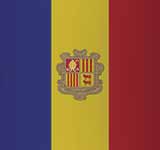
153. Antigua and Barbuda

154. Artsakh - Republic of Artsakh

155. Bahamas, The - Commonwealth of The Bahamas

156. Barbados

157. Brunei - Nation of Brunei, the Abode of Peace

158. Burundi - Republic of Burundi

159. Cape Verde - Republic of Cabo Verde

160. Central African Republic

161. Comoros - Union of the Comoros

162. Cook Islands

163. Cuba - Republic of Cuba

164. Dominica - Commonwealth of Dominica

165. East Timor - Democratic Republic of Timor-Leste

166. Equatorial Guinea - Republic of Equatorial Guinea

167. Eritrea - State of Eritrea

168. Eswatini - Kingdom of Eswatini

169. Fiji - Republic of Fiji

170. Gambia, The - Republic of The Gambia

171. Grenada

172. Guinea-Bissau - Republic of Guinea-Bissau

173. Guyana - Co-operative Republic of Guyana

174. Kiribati - Republic of Kiribati

175. Korea, North - Democratic People's Republic of Korea

176. Laos - Lao People's Democratic Republic

177. Liechtenstein - Principality of Liechtenstein

178. Maldives - Republic of Maldives

179. Marshall Islands - Republic of the Marshall Islands

180. Micronesia - Federated States of Micronesia

181. Monaco - Principality of Monaco

182. Nauru - Republic of Nauru

183. Niue

184. Oman - Sultanate of Oman

185. Palau - Republic of Palau

186. Papua New Guinea - Independent State of Papua New Guinea

187. Rwanda - Republic of Rwanda

188. Sahrawi Arab Democratic Republic

189. Saint Kitts and Nevis - Federation of Saint Christopher and Nevis

190. Saint Lucia

191. Saint Vincent and the Grenadines

192. Samoa - Independent State of Samoa

193. San Marino - Republic of San Marino

194. Seychelles - Republic of Seychelles

195. Solomon Islands

196. Somaliland - Republic of Somaliland

197. South Ossetia - Republic of South Ossetia–the State of Alania

198. Suriname - Republic of Suriname

199. Syria - Syrian Arab Republic

200. São Tomé and Príncipe - Democratic Republic of São Tomé and Príncipe

201. Tanzania - United Republic of Tanzania

202. Tonga - Kingdom of Tonga

203. Transnistria - Pridnestrovian Moldavian Republic

204. Tuvalu

205. Vanuatu - Republic of Vanuatu

206. Vatican City - Vatican City State


